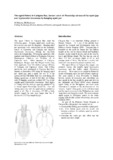| dc.identifier.citation | Moncay, H. P., & Cablo, L. P. (2007). Fish catch and fisher incomes before and after installation of artificial reefs in Panguil Bay, northern Mindanao. In T. U. Bagarinao (Ed.), Research Output of the Fisheries Sector Program (Vol. 2. Reports on Fisheries and Aquaculture, pp. 165-177). Quezon City, Philippines: Bureau of Agricultural Research, Department of Agriculture. | en |
| dc.description.abstract | Two artificial reef complexes (10 modules) were deployed in Panguil Bay in 1990. The effect of the ARs on the fish catch and fisher incomes was studied from March 1993 to April 1994 in Purok 3, 4, 6, and 7 in San Antonio, Ozamis City and in Poblacion 1 and 4 in Clarin, Misamis Occidental. Clarin‘s 40 full-time fisher respondents had 50 outrigger boats, all without engines, and used 181 fishing gears, 93% of them simple or multiple hand lines. San Antonio‘s 80 full-time fisher respondents had 87 non-motor boats and 44 motor boats and used 489 fishing gears, 86% of them bottom-set gill nets. The fishers worked an average of 19 days a month and four hours a day. The fishing grounds were mostly between 3 and 3.5 km from shore, and the gears were operated in waters about 50 m deep. Of about 17,000 kg of fish harvested in Clarin and San Antonio over one year, 33% came from bottom-set gill nets, 32% from bottom-set long lines, and 28% from multiple hand lines. The catch included a great variety of fishes, plus shrimps and cuttlefish; threadfins made up 13% of the total volume by weight, slipmouths 10%, and sardines 7%. The catch ranged from 2,382 kg valued at P75,862 in Purok 3 to 3,212 kg worth P97,303 in Poblacion 1, but in Purok 7, the catch was 2,965 kg worth P123,195. The average annual revenues of fishers was P24,191 in San Antonio and P11,472 in Clarin, corresponding to monthly earnings of P2,016 and P956, respectively. The revenues and net incomes were low, but the returns on investment were high (78–300%). The fishing boat, with or without engine and gas, was the major expense incurred by the fishers. Between 1989 and 1993–94, the volume of fish catch increased two-fold in San Antonio and four-fold in Clarin. The average annual income of fishers in the six villages increased by 10–60% after the ARs, and the average annual expenses also increased by 5–30%. In 1993-94, the computed return on investment was 105% in San Antonio and 274% in Clarin, higher than in 1989. | en |



